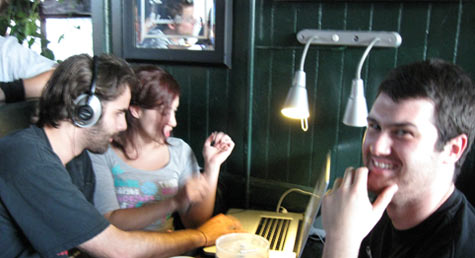
MULTITASKING The 12 Gauge crew |
The filmmakers scrambled upstairs Sunday night, spilling beers as they went, desperate to meet the deadline for the 48 Hour Film Project, an annual adventure in speedy cinematography.
Some were still tucked into booths at the Blackstone club in Pawtucket, editing their films on laptops. One greasy-haired teenager asked rivals for a blank DVD to burn his work.
Jay Walker, who runs the Providence version of the national event, kept order in his unbuttoned Hawaiian T-shirt by climbing atop a restaurant divider and telling the herd to get in line or risk missing the deadline.
To miss would be a crushing blow for filmmakers who had worked straight through the weekend to make a mini-movie, four to seven minutes long, including a common line of dialogue ("I'm pretty sure that's not right"), a common character (an addict named Sam or Sonya Needham), and a common prop (a coffee pot or coffee maker).
But director Ricky Laprade's team had it in the bag. Having submitted their film with minutes to spare, they were cool — if not quite collected.
The group was hopped up on energy drinks, after all, and deprived of sleep after writing, taping, and editing impromptu karate scenes and expletive-laced tirades throughout the weekend.
Laprade's team, dubbed 12 Gauge Pictures, had the flow down from the start. Told to make a mockumentary (other groups had to put together a comedy, drama, or ghost movie), the team took off to its studio in West Warwick, started writing, and then shot completed scenes by Saturday. Sunday was spent editing. Despite a minor editing glitch, the team was done with hours to spare.
The movie, Laprade said, practically wrote itself. The group parodied an industry it knows well: film. There's the strung-out actress, the frustrated-to-no-end writer, and a lighting guy who somehow winds up playing a serial killer after the original actor goes missing. Murder, perhaps, as the apathetic cast suggests in interviews.
Laprade, who directed the mockumentary, also plays a central character in the film: an egocentric director named Chase Belafonte who looks like he should be selling cocaine in downtown Los Angeles, circa 1984.
He carries around a walkie-talkie, making demands of some character who never appears — who may not even exist — and calls the entire cast Frank, regardless of gender. Asking for more "peril," Belafonte makes his editor's life a living hell, barraging him with requests to insert topless girls, aliens and sharks into the script.
Laprade said the character wasn't that much of a stretch. Pump him full of enough drugs, he said, and he could morph into Belafonte with little trouble.
"He's how I [would] picture myself if I did way too much acid," Laprade said. "That's why I'm steering clear of it."
The crew shot most of the film at Optic Sugar, a graphic design studio in Providence. But some of the fight scenes, central to the film-within-the-film, were shot down the street in Prospect Park.
The team told Providence Police, in advance, that they would be filming karate confrontations. "The last thing we need is for the PD to think we're terrorists," said Laprade.
The film was to be judged, alongside its competitors, during screenings at the Columbus Theatre throughout the week. But Chase Belafonte would live on, Laprade said. And he'd look good doing it.
"He's going to dress even more like an asshole."